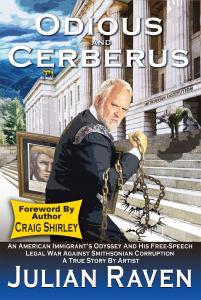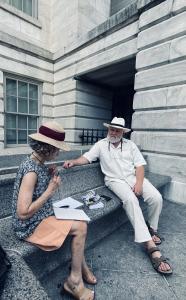WHY SENATOR GRASSLEY’S SMITHSONIAN FOIA (Freedom of Information Act) REFORM BILLS FAILED
This legal entity status confusion is nothing new, though. The problem stretches right back to the very founding of the Smithsonian Institution. Joseph Henry, the first Smithsonian Secretary, authoritatively sounded the alarm and warned regarding the same entity confusion in the first official Smithsonian vision and purpose statement, ratified by the Smithsonian Board of Regents. The Board of Regents, consisting of representatives from the separate tri-part government branches and public members, could create a massive constitutional problem if the entity status were allowed to morph into something the Smithsonian was never meant to be. This distortion would violate the boundaries of the separation of powers if left ill-defined.
In the ‘Programme of Organization’ from 1848, in their capacities as merely trustees or trustee delegates, The Vice President, the Chief Justice, three members of Congress, three members of the Senate, and members of the public all agreed with Secretary Joseph Henry’s first, second and third article, in a legally binding quorum that, “1. The property is bequeathed to the United States…2. The bequest is for the benefit of mankind...the government of the United States is merely a trustee to carry out the design of the testator. 3. The institution is NOT a national establishment as is frequently supposed, but the establishment of an individual, and is to bear and perpetuate his name.”
Now compare Smithsonian Secretary Henry’s statement with this recent statement from the chairman of the Committee on Oversight and Government Reform, Congressman Jason Chaffetz. In the 2016 attempt to wrestle and ride the Smithsonian beast into submission, Chaffetz said that the Smithsonian was “...originally established by a gift to the United States government of more than $500,000...” Do you see the glaring government error and consequential creep that has deceived even those trying to reform the Smithsonian from the inside? (Please reread the previous paragraph.) Also, compare this fact from the congressional Smithsonian Act of 1846, where immediately upon receipt of James Smithson’s gold, in the second article of the same act, the private money, “...the sum of five hundred and fifteen thousand one hundred and sixty-nine dollars, be lent to the United States Treasury at six percent per annum interest,...”
If the government borrowed the Smithson bequest held in trust by the government, how can the money be at the same time the government’s money, as claimed by Congressman Jason Chaffetz? Simply put, it is not. And this is again the whole problem with the Smithsonian Institution, its entity status, or legal composition. Was the money ever paid back? Interestingly, Smithson’s bequest was never used in the establishment of the Smithsonian Institution. Congress used the accrued 6% annual interest they owed on the loan over the nearly ten years it took for Congress actually to build the Smithsonian.
Senator Grassley, back in 2007, began his unsuccessful efforts to lay hold of the slippery legal eel on the floor of the Senate, saying, “The legal status of the Smithsonian is also an open question with the prevailing law finding that for purposes of the Privacy Act and FOIA, the Smithsonian is not a government “agency'' subject to the requirements. Instead, the Smithsonian calls itself a ‘trust instrumentality of the United States.’ However, the Smithsonian takes a different position when it is faced with a lawsuit filed under the Federal Tort Claims Act and considers itself a ‘federal agency.’ Taken together, these decisions have given the Smithsonian the best of both worlds--they are a government entity when information is sought that could embarrass them, but when they are sued, they get all the defenses of a government entity.”
In Julian Raven’s new book, ‘Odious and Cerberus: An American Immigrant’s Odyssey and his Free-Speech legal War against Smithsonian Corruption”, Raven exhaustively documents the legal schizophrenia he too encountered, which is pertinently illustrated in Federal Judge Trevor McFadden’s ruling. (District Court case number: 1:17-cv-01240 (TNM)) The judge claimed that the Smithsonian Institution is the government “through and through…the National Portrait Gallery has historically communicated messages from the government, in the sense that it compiles the artwork of third parties for display on government property” and yet Peter G. Powers, former Smithsonian’s general counsel, from another Smithsonian scandal documented in the book, said, “that virtually all Smithsonian properties, including the museums on the Mall in Washington, legally belong to the Institution and not to the federal government….” In a speech written for Chief Justice Warren Burger, he quotes Chief Justice Howard Taft in his capacity as Smithsonian Chancellor saying, “The Smithsonian is not, and never has been considered a government bureau. It is a private institution under the guardianship of the government.”
Raven's story has been making the rounds on IOWA talk radio. Raven recently appeared on the Simon Conway Show and with Jeff Stein, among others.
To hear current interviews regarding his book, please go to www.odiousandcerberus.com/media
Contact info@julianraven.com to set up an interview.
Click here to Purchase and Read the full Smithsonian expose 'Odious and Cerberus: An American Immigrant's Odyssey and his Free-Speech Legal War Against Smithsonian Corruption' By Julian Raven
Julian Raven
Julian Raven Artist
email us here
Visit us on social media:
Facebook
Twitter
LinkedIn
Artist and Author Julian Raven talks about his new book 'Odious and Cerberus: An American Immigrant's Odyssey and his Free-Speech-war' on the Andrew Wilkow Show
Legal Disclaimer:
EIN Presswire provides this news content "as is" without warranty of any kind. We do not accept any responsibility or liability for the accuracy, content, images, videos, licenses, completeness, legality, or reliability of the information contained in this article. If you have any complaints or copyright issues related to this article, kindly contact the author above.



